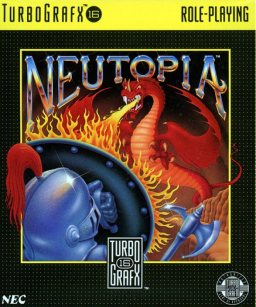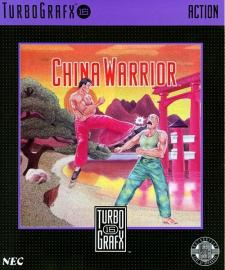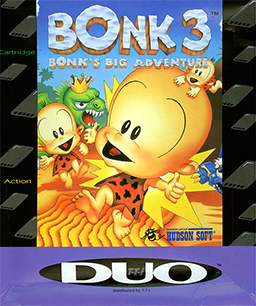
The TurboGrafx-16, known as the PC Engine outside North America, is a home video game console designed by Hudson Soft and sold by NEC Home Electronics. It was the first console marketed in the fourth generation, commonly known as the 16-bit era, though the console has an 8-bit central processing unit (CPU) coupled with a 16-bit graphics processor. It was released in Japan in 1987 and in North America in 1989. In Europe, the console is known as the PC Engine, after the Japanese model was imported and distributed in the United Kingdom and France from 1988. In Japan, the system was launched as a competitor to the Famicom, but the delayed United States release meant that it ended up competing with the Sega Genesis and later the Super NES.

Salamander, retitled Life Force in North America and in the Japanese arcade re-release, is a scrolling shooter arcade video game by Konami. Released in 1986 as a spin-off of Gradius, Salamander introduced a simplified power-up system, two-player cooperative gameplay and both horizontally and vertically scrolling stages. Some of these later became normal for future Gradius games. In Japanese, the title is written using ateji, which are kanji used for spelling foreign words that has been supplanted in everyday use by katakana. Contra, another game by Konami was also given this treatment, with its title written in Japanese as 魂斗羅.

Air Zonk, known in Japan as PC Denjin, is a horizontally scrolling shooter released for TurboGrafx-16 in 1992. Air Zonk was an attempt to update the company's image via a modern, punkish character called Zonk, who bears a purposeful resemblance to the TurboGrafx-16's caveman mascot, Bonk.
Bonk, known as PC-Genjin in Japan and as PC Kid or BC Kid in PAL territories, is a video game character and former mascot for NEC's PC Engine/TurboGrafx-16 video game console. Three platform games featuring the character appeared on the PC Engine/TurboGrafx-16, as well as two spin-offs featuring Air Zonk. The protagonist is a bald caveman named Bonk who attacks using his comically large head.

Neutopia is an overhead action-adventure video game developed by Hudson Soft. It was released by Hudson for the PC Engine in Japan on November 17, 1989. It was then released by NEC for the TurboGrafx-16 in North America in 1990. It was re-released for the Virtual Console service worldwide for the Wii in 2007; it was re-released for the PlayStation Network in Japan in 2010 and in North America in 2011. It was re-released for the Wii U on April 16, 2014 in Japan, and in USA and Europe in 2017. The game takes place in the land of Neutopia, where the evil demon Dirth has captured Princess Aurora and has stolen the eight ancient medallions which contain the wisdom and power necessary to maintain peace and prosperity throughout the land. It is up to the protagonist Jazeta to retrieve the eight medallions, defeat Dirth, rescue Princess Aurora, and save the land and its people.

Star Force, also released in arcades outside of Japan as Mega Force, is a vertical-scrolling shooter computer game released in 1984 by Tehkan.

Military Madness is a 1989 turn-based strategy video game originally developed and published by Hudson Soft in Japan and NEC in North America for the TurboGrafx-16. It is the first entry in the Nectaris series. Set in the year 2089, players take command of the Allied-Union forces in a desperate offense against the Axis-Xenon Empire army on the Moon before they launch the S.A.M. weapon to obliterate Earth. Its gameplay consists of moving units into positions to confront enemies in turn-based encounters determined by multiple factors, capturing factories to produce resources and repair units in order to occupy the enemy prison camp or destroy all enemy forces.

Famicom Wars is a wargame developed by Nintendo and Intelligent Systems and published by Nintendo for the Famicom. It was released on August 12, 1988 in Japan. It was later re-released on Virtual Console. It is the first game in the Wars series.
The Virtual Console was a line of downloadable video games for Nintendo's Wii and Wii U home video game consoles and the Nintendo 3DS handheld game console.

Alien Crush is a pinball video game developed by Compile for the PC Engine/TurboGrafx-16. It was released in 1988. The game is the first installment in the Crush Pinball series. It was followed by three sequels, Devil's Crush, Jaki Crush, and Alien Crush Returns. Alien Crush was later rereleased on the Virtual Console and on the PlayStation Network.

Bonk's Adventure, known as PC Genjin in Japan and PC Kid in Europe, is a scrolling platform game developed by Red Company and Atlus and released in 1989 in Japan and 1990 in North America for the PC Engine/TurboGrafx-16. The Japanese title PC Genjin is a play on the system's original name, PC Engine, with the European title PC Kid similarly referencing the system's name. The first game in the Bonk series, it was followed by two more games for the TurboGrafx-16 before branching out to other platforms.

Neutopia II is a 1991 action-adventure/action role-playing video game developed and published in Japan by Hudson Soft and in North America by Turbo Technologies for the TurboGrafx-16. It is the sequel to Neutopia, which was released earlier in 1989. In the game, the player takes control of Jazeta's son, who embarks on a quest to both save his father and defeat the returning evil demon Dirth.

China Warrior, known as The Kung Fu in Japan, is a beat 'em up video game created in 1987 by Hudson Soft for the PC Engine/TurboGrafx-16. The game received mixed reviews upon release, with praise for its large sprite graphics but criticism towards its gameplay.

Gunhed, known as Blazing Lazers in North America, is a vertically scrolling shooter game by Hudson Soft and Compile, based on the Japanese film Gunhed. The title was released in 1989, for the PC Engine in Japan and re-skinned for the TurboGrafx-16 in North America, with Gunhed unofficially imported for the PC Engine in Europe. In the game, a fictional galaxy is under attack by an enemy space armada called the Dark Squadron, and this galaxy's only chance for survival is the Gunhed Advanced Star Fighter, who must destroy the Dark Squadron and its Super Weapons. The gameplay features fast vertical scrolling and a wide array of weapons for the player to use.
Star Soldier is a series of shoot 'em up video games mainly developed by Hudson Soft. Konami has owned the rights to the series since their absorption of Hudson Soft in 2012. The first game, named Star Soldier, appeared on the MSX and NES in 1986, and the series has continued on various gaming systems. Star Soldier itself has received enhanced remakes for both the GameCube and PlayStation 2 in 2003, and a different remake for the PlayStation Portable in 2005, while the latest installment of the series was released on the Wii as a WiiWare game in 2008. In addition, Super Star Soldier, Final Soldier, Soldier Blade and Star Parodier have been re-released on the Wii's Virtual Console and on the Japanese PC Engine's Best Collection lineup for the PSP. The Star Soldier games are best known for their distinctive music, unique weapon power-ups, and a special time attack high score mode called "Caravan Mode".

Soldier Blade is a 1992 vertical-scrolling shooter video game developed and published by Hudson Soft for the TurboGrafx-16. Controlling the titular starship, the player is tasked with completing each of the game's seven stages in order to wipe out the Zeograd Army, an alien race bent on conquering Earth. The game is the fourth entry in the Star Soldier series and shares many similarities with its predecessor Super Star Soldier, with Soldier Blade having a heavy emphasis on speed.

Bonk 3: Bonk's Big Adventure is an action video game released for the TurboGrafx-16 in 1993, the third game in the Bonk video game series.

Devil's Crush is a pinball video game developed by Compile for the TurboGrafx-16 and released in 1990. The second installment in the Crush Pinball series after Alien Crush, the game has an eerie occult theme with skulls, skeletons, and demons. It was later followed by Jaki Crush and Alien Crush Returns.

Gate of Thunder is a 1992 scrolling shooter video game developed by Red Company and published by Hudson Soft for the TurboGrafx-CD. It was the first game released in North America to support the Super CD-ROM² format and served as one of the pack-in games for the TurboDuo, a two-in-one system which runs both TurboGrafx-CD and TurboGrafx-16 titles, where it was bundled with Bonk's Adventure, Bonk's Revenge and Bomberman on the same disc. In the game, the player controls the Hunting Dog space fighter craft, piloted by space cop Hawk. Alongside his ally Esty, piloting the Wild Cat support ship, Hawk must stop General Don Jingi and his Obellon armada from obtaining the powerful "Starlight" energy source from planet Aries.

Star Parodier is a vertical-scrolling shoot 'em up video game developed by Kaneko and published by Hudson Soft for the PC Engine CD-ROM² in 1992. It is a spin-off of the Star Soldier series and was localized for North America as Fantasy Star Soldier, but this version was never released. The game was released for the Wii Virtual Console on March 7, 2008 in Japan, March 16 in Europe and later in North America on August 11. The title is also playable on the Turbografx-16/PC Engine Mini Console.


















